Thursday 24th
November, 2011 Dana Guest house, North Kuta, Bali, Indonesia,
Total coffees: 8
Despite being delayed,
our arrival in Indonesia was almost entirely without incident. Which
was a welcome relief given the stress that our last few days at the
hostel had brought.
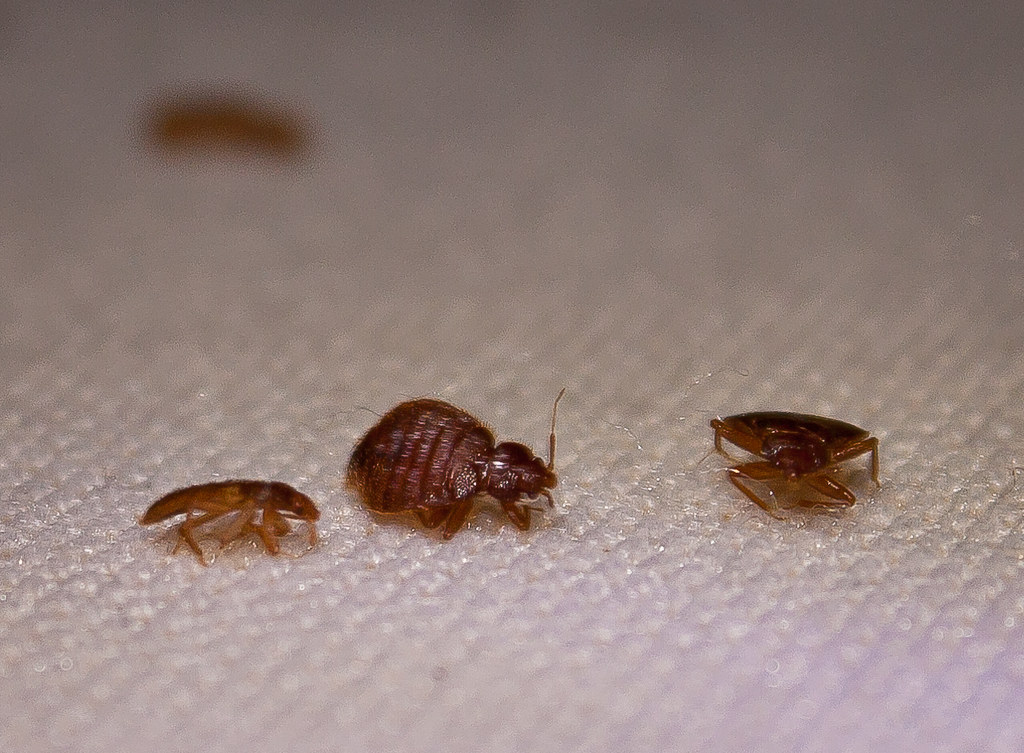 |
| Bed bugs: Difficult,but not impossible, to kill |
So on the 20th,
as well as having to pack all of our gear up, and rebox the bikes, we
had to first of all place everything in black plastic bags in the sun
again, all our clothes through the drier, and then repack everything
again after. It was a pain in the ass, but it came as no surprise
that the hostel was riddled since they didn't even bother to tell our
room mate that the room was infested, and had moved new people in by
the time we were leaving. We explained the problem to our ex-room
mate, the mad Israeli, but he didn't seem to understand the problem,
and the last thing we heard was that he was more concerned that his
magnifying glass had gone missing, that he needed to inspect his
supply of cannabis.
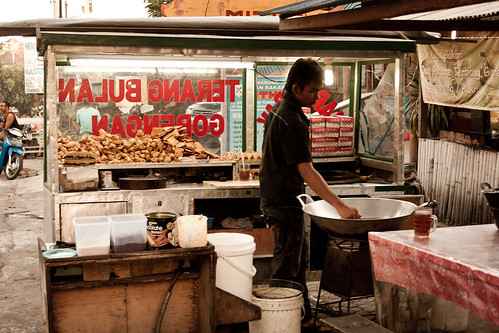 So, it was a great
relief to arrive in Denpassar to find our bicycle boxes waiting by
the carousal, and our panniers were already trundling around the
black belt ready for us to pick them up. Our plane was two and a half
hours late, but our pick up from the airport was still waiting for
us, a cheerful guy called Mede, and he helped us wheel our overloaded
trolley to the car and ram everything in the back. In case you've
ever wondered: it is possible to fit two bicycle boxes in a family
estate - but you have little room for anything else. Liv sat on my
knee in the front seat as we drove along roads streaming with mopeds.
So, it was a great
relief to arrive in Denpassar to find our bicycle boxes waiting by
the carousal, and our panniers were already trundling around the
black belt ready for us to pick them up. Our plane was two and a half
hours late, but our pick up from the airport was still waiting for
us, a cheerful guy called Mede, and he helped us wheel our overloaded
trolley to the car and ram everything in the back. In case you've
ever wondered: it is possible to fit two bicycle boxes in a family
estate - but you have little room for anything else. Liv sat on my
knee in the front seat as we drove along roads streaming with mopeds.
The roads were busy but
not as chaotic as we had feared they might be. Horns were infrequent,
and when they did sound out our Mede pointed out that they were
"friendly horns" to let other drivers know their location
and intentions. Cars and scooters regularly overtook each other, but
the patience and care of all the drivers was palpable amid the
bustle.
 |
| Our local fruit market |
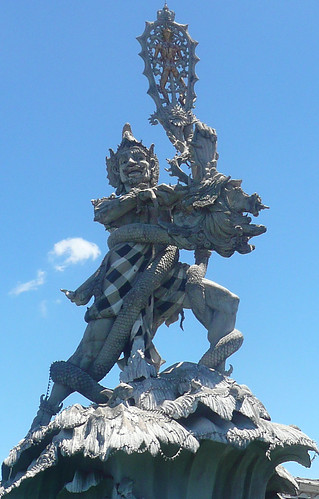
Painfully bright billboards loomed up on the side of the road, advertising mobiles, sporting events and concerts as they do all around the world. With adverts like that we could be in Brussels, Berlin, Beijing. Although we knew we weren't just anywhere as we passed the occasional gargantuan stone statue of a Hindu God watching over busy roundabouts - so high we had to crane our necks to see the detail of the car sized face at the top, surveying in silence the vehicles that buzzed around his feet. But as we came further from the airport these eye grabbing sights gave way to glimpses of something of the everyday life of the area. Tiny temples packed in between houses, food stands selling satay at the side of the road, and fruit markets sleeping beneath covers, waiting to lift them off and come to life in the morning. Traffic was there, the place was very much humming with life, but it was controlled and polite, and we both agreed that it seemed like Bali might be quite a reasonable place to cycle.
Our hostel was well out
of the way of everything; tucked away down a bumpy side road just big
enough for the taxi to wobble down. There were of course dogs
wandering around but they didn't seem to patrol the city in packs
like they do in Nepal, ready to pounce on anybody daring enough to
walk past after 10pm. Some even had collars. They'd appear from
between houses or sat up from their watch to regard the new arrivals,
then settled back down without making any fuss. We parked beside a
short run of bamboo fencing and began carrying the bags and boxes
across a small courtyard and into our room.
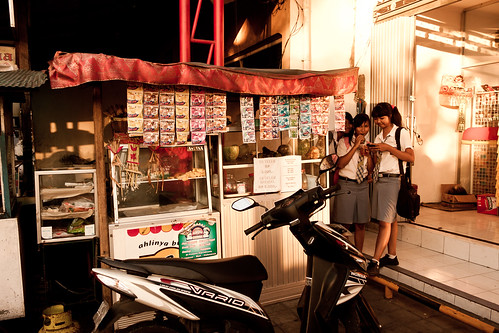 Our guest house,
situated in a residential area away from the city, consisted of a
little open air kitchen-come-reception and five small bungalows
surrounding a courtyard with a little fish pond and plenty of
greenery and shade. We had splashed out and booked somewhere nice
knowing we'd appreciate it after the hassle of flying from Australia.
We did. The room, the peacefulness, the other guests and the staff
were fantastic. A far cry from Kuta beach, the Ibiza of Asia. We have
spent five days here so far. A little bit of sitting around doing
nothing, a little bit of venturing out around the island, and a
little cycle trip out further afield.
Our guest house,
situated in a residential area away from the city, consisted of a
little open air kitchen-come-reception and five small bungalows
surrounding a courtyard with a little fish pond and plenty of
greenery and shade. We had splashed out and booked somewhere nice
knowing we'd appreciate it after the hassle of flying from Australia.
We did. The room, the peacefulness, the other guests and the staff
were fantastic. A far cry from Kuta beach, the Ibiza of Asia. We have
spent five days here so far. A little bit of sitting around doing
nothing, a little bit of venturing out around the island, and a
little cycle trip out further afield. |
| A jumping spider that joined us for breakfast. |
Faces smile as you pass
them, bats swoop overhead at night, geckos stalk the walls and back
alley chickens cluck and call to herald the rising of the sun each
morning. Everything feels alive here, energised, and it'd take
several dozen bintang beers to blind you from it.
Which is not to say
Bali doesn't have its problems. Open drains waft out a smell akin to
marzipan mixed with rotting worms, there are children going hungry on
the streets (although this is not as big a problem as in other
countries we've been to), and many of the street dogs look less than
salubrious. And there is of course the nightly hoard of soulless
drunks that crash loudly through Kuta, sapping the spirit from the
land and from all the hawkers that make themselves a living there and
who have to attract business by selling things like anti-immigration
bumper stickers, drugs and reams of slogan splattered t-shirts.
Thankfully this is very much contained, and we have almost entirely
avoided it. If getting smashed is your thing though, I hear Kuta is a
blast. But why not save on the airfare and just get smashed at home,
because that is what Kuta is trying to emulate. Stay at home.
Especially if you're the kind of person so zealously opposed to
foreigners that you would be willing to purchase a sticker insulting
them and openly displaying it on the rear end of your vehicle. Surely
you ain't got nuffin against other cultures, just as long as they
ain't in your culture, yeah? Well then, leave Bali alone.
 Having spent a few days
roaming the locale, yesterday we decided it was high time to get the
bikes out on the roads. We left in the morning, unloaded, and headed
west out of the city. It took us a while to break out of the clogged
roadways. Rush hour lingers well after 10 a.m, and we found ourselves
creeping along streets rammed bumper to exhaust with vehicles. It
might have been stressful, if it weren't for the thrill of actually
having a go at Asian style traffic – shortcutting up the kerb,
weaving between cars, dodging the odd bloke who's decided to ride the
wrong way up the road. It's also great moving at the same pace as all
the rest of the traffic, although this is because everybody's
staccatoing forward at about 2 kmph, admittedly. As I say though, the
experience was brief, and within half an hour we found ourselves on
country roads, curving along wide open rice paddies, with the sun
flaming above.
Having spent a few days
roaming the locale, yesterday we decided it was high time to get the
bikes out on the roads. We left in the morning, unloaded, and headed
west out of the city. It took us a while to break out of the clogged
roadways. Rush hour lingers well after 10 a.m, and we found ourselves
creeping along streets rammed bumper to exhaust with vehicles. It
might have been stressful, if it weren't for the thrill of actually
having a go at Asian style traffic – shortcutting up the kerb,
weaving between cars, dodging the odd bloke who's decided to ride the
wrong way up the road. It's also great moving at the same pace as all
the rest of the traffic, although this is because everybody's
staccatoing forward at about 2 kmph, admittedly. As I say though, the
experience was brief, and within half an hour we found ourselves on
country roads, curving along wide open rice paddies, with the sun
flaming above. |
| Indonesians are a very friendly bunch. |
We had decided to visit
a famous temple called Pura Tanah Lot. 'Pura' means temple, 'Tanah':
earth, 'Lot': dunno yet. It was only 12km away, and the ride was
reassuringly smooth. Traffic was light – just a couple of trucks
and mopeds passing every minute or two, and passing, let us stress,
with a level of care that made us feel comfortable. The roads were
sealed the whole way, and every kilometre or so we dropped out from
green vistas into small villages where white clad festival goers
strolled, bands of musicians played, and 'warung' (food store) owners
stood regarding the world as it rolled by, before rising out and back
along the sedate agricultural landscape.
 |
| Pura Tanah Lot |
Tanah Lot came as a bit
of a surprise when we got there. For a start, it had multiple
carparks, a permanent Ralph Lauren store, and was sponsored by an
Indonesian pot noodle. It's a big draw, and stall after stall make a
living here. The temple itself is away on the beach, built into a
rock that has survived the erosion around it, and is home to a
freshwater spring. We walked down, got blessed at the spring by
washing ourselves in it, had someone push some rice onto our
forehead, then of course we paid the donation. It is not an easy task
to find spiritualism being offered without the assumption that cash
will change hands immediately afterwards, not in our experience
anyway. I suppose they have to make a living somehow, but religion is
very much compromised when it gets tangled up with such earthly
trivialities as money. Jesus never had to lend a tenner off Mark, did
he?
After sitting out the
midday monsoon we got on our bikes again and headed for Ubud, a town
30km north of Denpassar that we had heard good things about from
different sources. There was no direct route there, and our map did
not include road names so there was a lot of guess work, and the
compass had to come out a number of times at cross roads. We ate at
small warungs in little villages along the way, where we ate well for
less than $2 each, and where we could practise our Indonesian, or
more often than not, where the owners could fill in the holes of
understanding by practising their English.
At around 4pm we came
to Ubud, and a sign pointing out “Monkey forest”. No prizes for
guessing where we immediately diverted ourselves to. The monkey
forest is, a... erm... well... it's a forest full of monkeys in Ubud.
It has a fantastic list of rules outside the main entrance, including
#9 “Never grab a monkey.” We walked along the paved path with the
rest of the other tourists, and were immediately confronted by cocky
macaques who leapt up at our bikes in search of any tasty treats we
might be hiding. Monkey's are brilliant, as you are all well aware,
so we'll content ourselves with posting up a few photos, and tell you that we had a good hour of pure monkey action,
before ambling off into the town in search of some entertainment for
the evening.
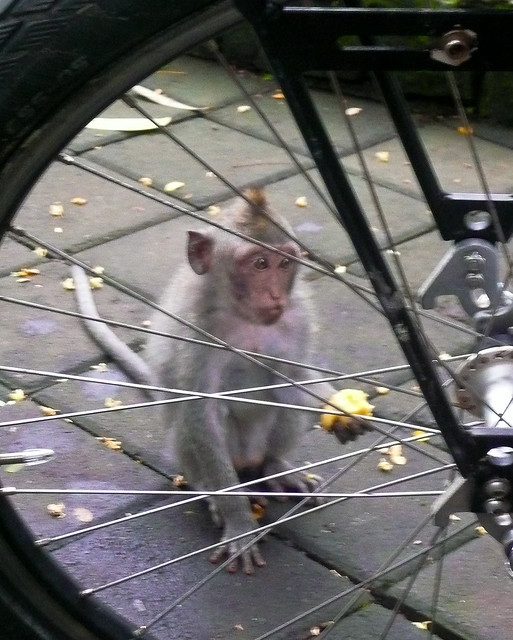 |
| Partario the monkey knew a good bicycle rack when he saw one |
 |
| This little monkey stole the emergency blanket out of my handlebar bag. |
Entertainment came in
the form of wayang kulit (“leather puppet”), it is a variation of
the shadow puppet traditions that permeate many other cultures in
Asia. A screen is strung up with a torch lit behind it, and a puppet
master manipulates leather characters to act out stories, while a
band of musicians behind the screen provide the accompanying music
and sound effects.
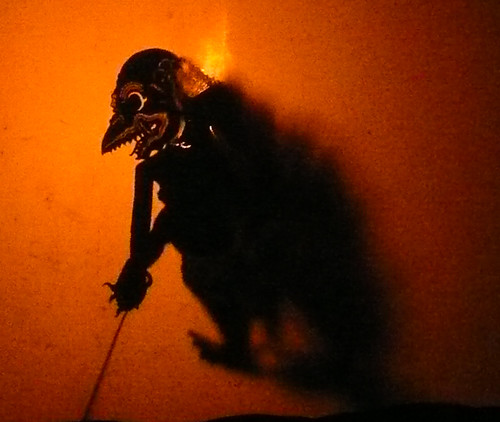 |
| You know it's going to be a good night's entertainment when one of the baddies is a saw-beaked pengi demon. |
Our confusion, which
did not override our fascination, was soon vanquished when the demons
did arrive, and the latter half of the play became lots of fighting
between demons and the other characters. A plot device I think almost
anybody from any culture would understand. The play was captivating,
and despite the fact we didn't understand the dialogue, the puppet
master did a great job of bringing the characters to life with little
touches, like one who ran his hands through his hair, one who farted
and scratched his arse a lot, and one who spoke nobly and raised his
hands up at significant moments. All this as well being dexterous
enough to manipulate two puppets simultaneously as they fought and
moved about the stage. Not bad for an 80 year old!
You will be relieved to
hear that Bima was victorious, and the demons were slain. If you ever
want to slay a demon the best way seems to tussle with it a bit, then
throw a spear at it. This method worked in about 4 of the 5 fights,
the final one, and the only exception, ending with Bima holding a
defeated Detya Baka by the neck, then freeze frame! And the magic
flying tree appeared and flew around a bit.
What a lovely evening!
Too bad we were 30km from our guest house, and it was already 9pm and
dark. Tired, a little daunted, but happy, we turned our lights on and
set off in the direction of Denpassar. Very quickly we realised that
we had very little to fear on the ride home. The roads were quiet,
and the scooters that buzzed past behaved themselves as much as they
had done during daylight hours. Besides swerving to avoid a street
dog with a death wish the journey went without incident, and we
coasted almost the whole way back, with a cool night breeze in our
faces. Navigating Denpassar was not quite so easy though, as our map
only showed main roads, and we were worried we might find ourselves
pedalling around until the early hours looking for the right turn
off. Thankfully though a kind man called Mede was riding home from
his shift at a hotel in town, and lived nearby. He asked us to follow
him, and he waited patiently at each set of lights to direct us. When
he finally left to take his turning home, Liv picked up the scent and
managed to get us home – if we'd stuck with the route I was taking
us we would have spent a long time riding through streets of
gardening shops. 30Km trip: 90 minutes. Beautiful.
Lihat Peta Lebih Besar
We intended to leave Denpassar for good the next day, and set out north to Mount Batur, a volcano to the north, but we both felt a little bit under the weather and decided to sit it out for a day. Which was great because it meant we wound up spending a night drinking with the locals at a billiard bar just up the road.
It all happened because Liv bumped into Jasmin and Kakouii, a couple who were in the process of constructing a bar of their own just up the road, and she invited them down to our lodge where we met up with them again, before ambling up the road to the billiard bar, which was just a concrete room with two billiard tables and a few plastic chairs outside. We sat and chatted, trying out our limited Indonesian and the local moonshine 'Arak'. “I like Bali.” “I like fish” “I like Arak.” Despite having the vocabulary of a chimp it was, and is, amazing how far a few words in another language have taken us so far. People are genuinely pleased when they hear you having a go, and are always patient while we flick through our phrase book and stand around mispronouncing things.
Lihat Peta Lebih Besar
We intended to leave Denpassar for good the next day, and set out north to Mount Batur, a volcano to the north, but we both felt a little bit under the weather and decided to sit it out for a day. Which was great because it meant we wound up spending a night drinking with the locals at a billiard bar just up the road.
It all happened because Liv bumped into Jasmin and Kakouii, a couple who were in the process of constructing a bar of their own just up the road, and she invited them down to our lodge where we met up with them again, before ambling up the road to the billiard bar, which was just a concrete room with two billiard tables and a few plastic chairs outside. We sat and chatted, trying out our limited Indonesian and the local moonshine 'Arak'. “I like Bali.” “I like fish” “I like Arak.” Despite having the vocabulary of a chimp it was, and is, amazing how far a few words in another language have taken us so far. People are genuinely pleased when they hear you having a go, and are always patient while we flick through our phrase book and stand around mispronouncing things.
After some time spent
listening to a fella strum his guitar, learning that in Bali the
reason why so many people are called Mede is because that is the
standard name given to the second born child, and chucking down half
a dozen Arak's and sprite shots, we stumbled home. Excellent
preparation for the next day, when we planned to set out north and
scale the heights of Bali. Hic.
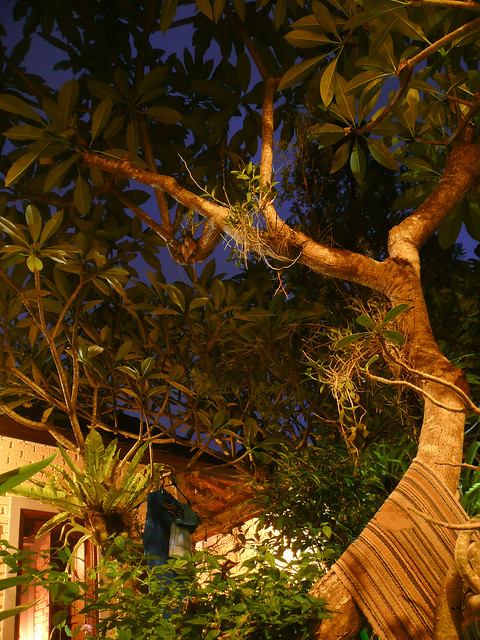 |
| The tree in the courtyard of Dana guesthouse. |



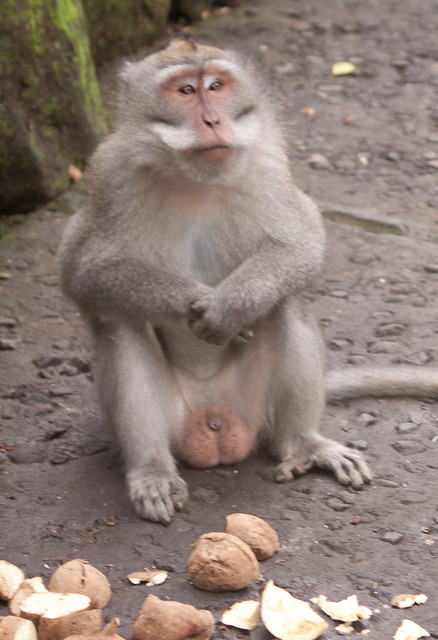


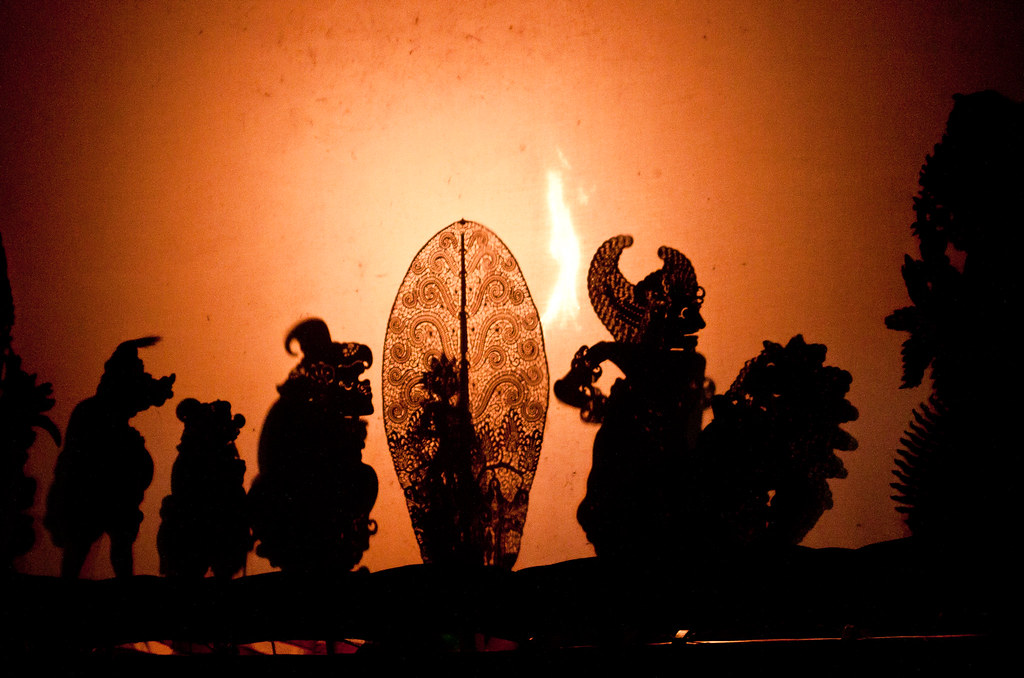
Your blog is absolutely incredible! I'm "planning" a similar trip...mostly researching and then just going. Do you have a list of what you packed and took with you? I saw something like a starting checklist scribbled over 2 sheets of paper in one of your posts. Something like that would be awesome for a fellow traveler! My email is patrick [dot] darsey [at] gmail [dot] com if that is easier.
ReplyDeleteThis comment has been removed by the author.
ReplyDeleteHi Pat,
ReplyDeleteHa, yes there's only so much planning you can do for a trip like this - and it's much better that way. I can give you a rough idea what we would pack if we were going to travel South East Asia again. Kit lists are enormously location-dependent though so do your research and use your head. If you're going to be near shops and towns it may be wise to underpack and buy additional stuff as you go, otherwise you end up with loads of unnecessary extra weight. That’s easier said than done.
Keep reading up Pat. It helps to have a store of info in your head so when you do get caught out you know what to do. I’ve put a few links that I found useful at the bottom of the list.
And good luck buddy. Adventures are few and far between these days it seems and cycling long distance really is an adventure. It won’t take you long to get in the swing of things. Once you do, push yourself a little more. Every time we took a risk and went off piste it was worth it – sometimes it retrospect, but worth it. Let us know how you get on. J
NB. This list is probably not exhaustive, just what I’ve thought up over the last couple of hours. (Sorry it took me so long to get back to you)
So:
ReplyDeleteFood & Drink:
· A MSR Dromedary bag - one of the most useful things we bought with us. Carries lots of water – be vigilant about keeping it topped up.
· Some good easy snacking food – Most of the time food won’t be a problem, there are warungs and restaurants all over SE Asia. However, you need a good stash of nuts and dried fruit to get you to the next stop if you run out of energy. Actually, you should probably be munching a handful every half an hour or so anyway to keep your energy levels up. Once you’ve “bonked” a few times, you’ll learn how much food you need to keep going and get into a good rhythm.
· A stove (if you’re camping) – We rarely needed to camp in SE Asia, although some of the best bits did demand it (Mae Sot to Chiang Mai, Thailand). Through the mountains in China we absolutely needed our tent too, there would have been no other way of doing it. So, if you are camping you’ll need a stove. We used the MSR Whisperlite International but it’s very messy and slow to get going. The good news is it’ll burn anything so you can get fuel all around the world. However, in China when we were out in the wilderness and camping nearly every night we found it was quicker and more practical to make a small fire and cook on that. I’m back home now, and on weekend rides we’re trailing the Coleman gas canister stoves which are much quicker and cleaner – but the fuel would rarely be available.
· Some tinned/long lasting food for cooking (if you’re camping, and probably a tin or two if you’re not for emergencies) – Rice, tinned mackerel, cured meats, lentils, dried mushrooms, dried beans, etc etc. You can make some sterling meals on a little camp stove. Don’t forget to bring some seasoning too.
Clothes:
· A hat – keeps the sun off your head.
· Shades
· A poncho – For the rains
· I wore t-shirts and shorts almost the whole time through SE Asia, they were fine.
Bike kit:
· Front & rear lights + high vis sash/jacket – You will get caught out at night at somepoint.
· Rearview mirror
· A toolkit – and the knowledge of how to repair punctures, refit gear and brake cable, fit pedals, and tweak gears.
· Spares - gear and brake cable, inner tube, chain/chain links (though I’d say get the chain – it’s quicker to whack a whole new chain on than to fiddle)
· A brooks saddle with the springy back bit – we hardly ever had a sore bum
Sleeping:
ReplyDelete· A roll mat/inflatable mattress – essential if you intend to rough it. Try sleeping on the floor without one. It is horrendous.
· A mosquito net – we found camping almost unbearably hot in SE Asia. Most of the time we resorted to finding shelter (monastery, restaurant, motorbike monsoon shelter) and just erecting the mosquito net because the water proof cover turned the thing into a sauna.
· Some bungees – tying kit down, and combine with your poncho, some pegs and two trees for a makeshift rain shelter.
· A small pillow (if you’re camping) – Fluffy tube-like handwarmers work a treat, so do the silver bags from the inside of a box of wine: drink the contents then wrap it in a comfy material for a blow up solution to your aching neck.
Other kit:
· A map
· A compass – long trips are easy to navigate, just figure out which direction you’re heading and go that way. Also works to get you out of the big cities.
· Suncream
· Malaria tablets
· Medikit
Useful links:
Adventure cycle handbook - http://www.amazon.co.uk/Adventure-Cycle-Touring-Handbook-Worldwide-Planning/dp/1905864256
Mr pumpy - http://www.mrpumpy.net/
Travelling two - http://travellingtwo.com/
Bill Weir’s Journals - http://www.crazyguyonabike.com/directory/?o=1&user=billweir&v=G
Alastair Humphreys - http://www.alastairhumphreys.com/
Rob Lilwall - http://roblilwall.com/